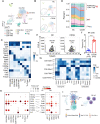Single cell sequencing reveals that CD39 inhibition mediates changes to the tumor microenvironment
- PMID: 36347860
- PMCID: PMC9643495
- DOI: 10.1038/s41467-022-34495-z
Single cell sequencing reveals that CD39 inhibition mediates changes to the tumor microenvironment
Abstract
Single-cell sequencing technologies have noteworthily improved our understanding of the genetic map and molecular characteristics of bladder cancer (BC). Here we identify CD39 as a potential therapeutic target for BC via single-cell transcriptome analysis. In a subcutaneous tumor model and orthotopic bladder cancer model, inhibition of CD39 (CD39i) by sodium polyoxotungstate is able to limit the growth of BC and improve the overall survival of tumor-bearing mice. Via single cell RNA sequencing, we find that CD39i increase the intratumor NK cells, conventional type 1 dendritic cells (cDC1) and CD8 + T cells and decrease the Treg abundance. The antitumor effect and reprogramming of the tumor microenvironment are blockaded in both the NK cells depletion model and the cDC1-deficient Batf3-/- model. In addition, a significant synergistic effect is observed between CD39i and cisplatin, but the CD39i + anti-PD-L1 (or anti-PD1) strategy does not show any synergistic effects in the BC model. Our results confirm that CD39 is a potential target for the immune therapy of BC.
© 2022. The Author(s).
Conflict of interest statement
The authors declare no competing interests.
Figures







Similar articles
-
Transforming growth factor beta orchestrates PD-L1 enrichment in tumor-derived exosomes and mediates CD8 T-cell dysfunction regulating early phosphorylation of TCR signalome in breast cancer.Carcinogenesis. 2021 Feb 11;42(1):38-47. doi: 10.1093/carcin/bgaa092. Carcinogenesis. 2021. PMID: 32832992
-
Effect of nitric oxide inhibition in Bacillus Calmette-Guerin bladder cancer treatment.Nitric Oxide. 2020 May 1;98:50-59. doi: 10.1016/j.niox.2020.03.003. Epub 2020 Mar 6. Nitric Oxide. 2020. PMID: 32147582
-
DPP inhibition alters the CXCR3 axis and enhances NK and CD8+ T cell infiltration to improve anti-PD1 efficacy in murine models of pancreatic ductal adenocarcinoma.J Immunother Cancer. 2021 Nov;9(11):e002837. doi: 10.1136/jitc-2021-002837. J Immunother Cancer. 2021. PMID: 34737215 Free PMC article.
-
Harnessing the cDC1-NK Cross-Talk in the Tumor Microenvironment to Battle Cancer.Front Immunol. 2021 Feb 19;11:631713. doi: 10.3389/fimmu.2020.631713. eCollection 2020. Front Immunol. 2021. PMID: 33679726 Free PMC article. Review.
-
Are Conventional Type 1 Dendritic Cells Critical for Protective Antitumor Immunity and How?Front Immunol. 2019 Feb 12;10:9. doi: 10.3389/fimmu.2019.00009. eCollection 2019. Front Immunol. 2019. PMID: 30809220 Free PMC article. Review.
Cited by
-
Prediction of future research trends in bladder urothelial carcinoma: Bibliometric analysis.Medicine (Baltimore). 2024 Feb 16;103(7):e37176. doi: 10.1097/MD.0000000000037176. Medicine (Baltimore). 2024. PMID: 38363885 Free PMC article.
-
Therapeutic and immunomodulatory potentials of mesenchymal stromal/stem cells and immune checkpoints related molecules.Biomark Res. 2024 Mar 21;12(1):35. doi: 10.1186/s40364-024-00580-2. Biomark Res. 2024. PMID: 38515166 Free PMC article. Review.
-
Single-cell RNA sequencing and spatial transcriptome analysis in bladder cancer: Current status and future perspectives.Bladder Cancer. 2025 Feb 21;11(1):23523735251322017. doi: 10.1177/23523735251322017. eCollection 2025 Jan-Mar. Bladder Cancer. 2025. PMID: 40034247 Free PMC article. Review.
-
How oxygenation shapes immune responses: emerging roles for physioxia and pathological hypoxia.Nat Rev Immunol. 2025 Mar;25(3):161-177. doi: 10.1038/s41577-024-01087-5. Epub 2024 Sep 30. Nat Rev Immunol. 2025. PMID: 39349943 Review.
-
Metabolic instruction of the graft-versus-leukemia immunity.Front Immunol. 2024 Mar 4;15:1347492. doi: 10.3389/fimmu.2024.1347492. eCollection 2024. Front Immunol. 2024. PMID: 38500877 Free PMC article. Review.
References
-
- Siegel RL, Miller KD, Jemal A. Cancer statistics, 2020. CA Cancer J. Clin. 2020;70:7–30. - PubMed
-
- Burger M, et al. Epidemiology and risk factors of urothelial bladder cancer. Eur. Urol. 2013;63:234–241. - PubMed
-
- Ghandour R, Singla N, Lotan Y. Treatment options and outcomes in nonmetastatic muscle invasive bladder cancer. Trends Cancer. 2019;5:426–439. - PubMed
Publication types
MeSH terms
LinkOut - more resources
Full Text Sources
Medical
Molecular Biology Databases
Research Materials

